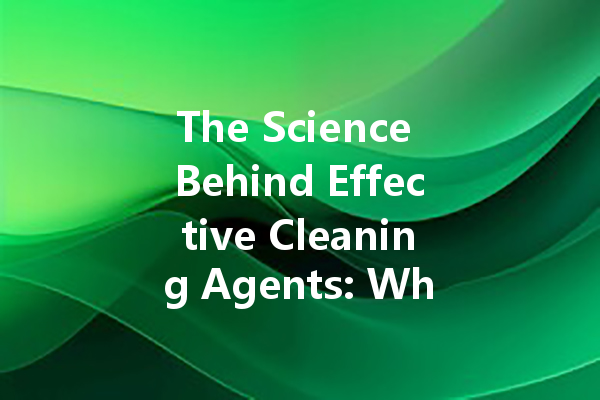Cleaning agents play a crucial role in maintaining hygiene and cleanliness in our homes, workplaces, and public spaces. Understanding the science behind these products, including their composition and effectiveness, can help consumers make informed choices, ensuring safe and effective cleaning practices. In this article, we will explore the key components of cleaning agents, their mechanisms of action, and how to choose the right products for your cleaning needs.
What Are Cleaning Agents?
Cleaning agents, also known as cleaning products or detergents, are substances designed to remove dirt, stains, and contaminants from surfaces. They come in various forms, including liquids, powders, sprays, and gels. Each type serves a specific cleaning purpose, from laundry detergents and dish soaps to all-purpose cleaners and disinfectants.
The Key Components of Cleaning Agents
Cleaning agents typically consist of several active and inactive ingredients:
Surfactants
Surfactants, or surface-active agents, are the primary active components in many cleaning products. Their molecular structure allows them to reduce the surface tension of water, enabling it to penetrate surfaces more easily. This helps to lift and emulsify dirt, grease, and grime, making it easier to wipe away.
Solvents
Solvents are liquids that dissolve other substances, aiding in the removal of stains and dirt. Common solvents found in cleaning agents include water, alcohols, and glycols. Solvents help to break down oily contaminants, allowing for a more thorough clean.
Acids and Bases
Some cleaning agents contain acidic or basic components to target specific types of stains. For instance, acidic cleaners are effective at removing mineral deposits, while alkaline cleaners work well on greasy or oily surfaces. The pH level of the cleaning agent can significantly impact its effectiveness, making it essential to choose the right formulation for the task at hand.
Fragrances and Dyes
While not essential for cleaning efficacy, fragrances and dyes are often added to cleaning agents to improve their appeal. Fresh scents can enhance the cleaning experience, while colors give products an attractive appearance. However, consumers should be cautious, as some fragrances and dyes may trigger allergies or sensitivities.
How Cleaning Agents Work
The effectiveness of cleaning agents is not solely determined by their individual components, but also by the interactions between those components and the surfaces being cleaned.
Wetting Action
When a cleaning agent is applied to a surface, the surfactants reduce water’s surface tension, allowing it to spread and penetrate more effectively. This wetting action lifts dirt away from surfaces and encapsulates it in micelles, preventing it from re-adhering.
Emulsification

For oily substances, surfactants work by forming emulsions. Emulsification occurs when the cleaning agent surrounds the oil or grease particles, suspending them in water. This allows for easy removal through rinsing or wiping.
Solubilization
Certain cleaning agents utilize the solvent properties to dissolve stains and debris. By breaking down the chemical bonds of the targeted substances, these agents enable efficient spot removal.
Disinfection and Antimicrobial Action
Some cleaning agents contain disinfectants that kill a broad spectrum of harmful microorganisms, including bacteria and viruses. This is particularly crucial in settings such as healthcare and food service, where sanitation is essential.
Choosing the Right Cleaning Agent
With so many options available, selecting the right cleaning agent for your needs can be overwhelming. Here are some key points to consider:
Understand Your Cleaning Needs
Before purchasing a cleaning agent, assess the surfaces and types of stains you need to address. For instance, different agents are more effective on carpets versus hard surfaces or in kitchens versus bathrooms.
Check the Ingredients
Read the label to understand the ingredients included in the product. Look for surfactants, solvents, and any disinfectants that may be beneficial. If you have allergies or sensitivities, avoid products with known irritants.
Consider Environmental Impact
If sustainability is important to you, seek out eco-friendly cleaning agents. These products often utilize biodegradable ingredients and come in recyclable packaging. They are designed to minimize harmful impacts on the environment.
Follow Instructions
To achieve the best results, follow the manufacturer’s instructions regarding usage, dilution ratios, and rinsing guidelines. Proper application will enhance the effectiveness of the cleaning agent.
Conclusion
Understanding the science behind effective cleaning agents empowers consumers to make educated choices that align with their cleaning needs and environmental values. By recognizing the essential components and mechanisms of action, individuals can select products that deliver optimal cleaning while ensuring household safety and hygiene. Whether tackling tough stains or maintaining a fresh environment, choosing the right cleaning agents can make all the difference.
